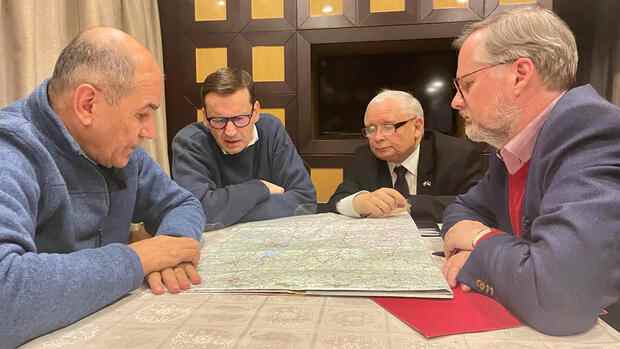Berlin The journey is risky, the means of transport unusual. Despite Russian attacks and explosions in the city, the leaders of Poland, the Czech Republic and Slovenia traveled by train to Kyiv on Tuesday to meet with Ukrainian President Volodymyr Zelenskyy – a powerful symbol of support for Ukraine.
In the evening, Poland’s Prime Minister Mateusz Morawiecki reports the arrival. “Here, in war-torn Kyiv, history is being made,” he wrote on Twitter. And posts pictures that show him with his deputy Jaroslaw Kaczynski as well as Czech Prime Minister Petr Fiala and his Slovenian colleague Janez Jansa at a table with a map of Ukraine. Where exactly they originated is unclear.
Mateusz Morawiecki, Petr Fiala and Janez Jansa thus confronted the Russian invasion directly. In this way they want to signal their support for Ukraine’s freedom struggle and present a package of concrete aid for the country attacked by Russia. The delegation was accompanied by Jaroslaw Kaczynski, the Polish Deputy Prime Minister and leader of the ruling national-populist Law and Justice Party (PiS).
Since the beginning of the war, Kyiv has been repeatedly hit by Russian missiles. Mayor Vitali Klitschko has just imposed a curfew from Tuesday evening to Thursday morning after further serious attacks. Many residents of the city are holding out in bunkers and shelters.
Top jobs of the day
Find the best jobs now and
be notified by email.
A flight to the embattled Ukrainian capital is unthinkable under these conditions. Otherwise it is currently not suitable as a travel destination for political celebrities. And so it came as a surprise when Poland’s government spokesman Piotr Müller announced on Tuesday morning that a train carrying the four top politicians was on its way to Kyiv and had already crossed the Polish-Ukrainian border.
Morawiecki’s head of office later tweeted that the train had passed through the western Ukrainian city of Lviv. Lviv was also the target of Russian rocket attacks on Sunday. The same applies to the Ukrainian military base Yavoriv – very close to the border with Poland.
Start probably in the train station of the eastern Polish city of Przemysl
According to Warsaw, the trip was planned “under the strictest secrecy”. The travel route also remains top secret for the time being.
However, there is only one track with Russian broad gauge, as laid in the Ukraine, in the station in the eastern Polish city of Przemysl. This suggests that the journey started there. Overcrowded trains are currently arriving in Przemysl from the opposite direction. They bring thousands of desperate people fleeing Ukraine.
The leaders of the three EU states, who traveled by train to the Ukrainian capital to meet President Volodymyr Zelensky and Prime Minister Denys Shmyhal, said in advance: “The aim of the visit is to give the EU full support for Ukraine and its freedom and to express independence,” Fiala wrote on Facebook.
The three prime ministers claimed that their visit to the war zone was a European Union mission. Morawiecki wrote on Facebook that he and the other prime ministers were “in agreement with the EU” on this “historic visit”.
Travel despite high security risks
The United Nations had also been informed in advance. “It’s not about us, it’s about the future of our children, who deserve to live in a world without tyranny,” wrote Morawiecki, announcing that a broad package of support for Ukraine and its citizens would be presented in Kyiv.
The visit had been planned for several days but was kept secret for security reasons, Morawiecki’s office manager Michal Dworczyk said. EU representatives spoke of a trip that the heads of government had undertaken independently of the EU, despite the security risks.
On the fringes of the last EU summit meeting at the end of last week in Versailles, both EU Commission President Ursula von der Leyen and Council President Charles Michel were informed. But there is no mandate from the European Council for the initiative, according to diplomatic circles in Brussels. Michel pointed out the risks of such a trip.
This is how the Handelsblatt reports on the Ukraine war:
In Poland, the visit brings back memories of an initiative by President Lech Kaczynski, who died in a plane crash in 2010. During the 2008 war in Georgia, Kaczynski traveled to Tbilisi with the presidents of Lithuania, Estonia and Ukraine, as well as the Latvian head of government, to show solidarity with the country in the conflict with Russia.
“The trip by Morawiecki and his counterparts to Kyiv is much more dangerous than Kaczynski’s visit back then,” says Jerzy Haszczynski, foreign policy expert for the Polish newspaper “Rzeczpospolita”. The journalist himself had just spent ten days in embattled Kyiv. Tbilisi was not under rocket fire in 2008. “No one was sitting in the bunker there.” It’s different now in Kyiv.
Russian troops attacked Kyiv again with artillery on Tuesday morning, according to Ukrainian sources. Two heavy explosions shook the city. Shock waves from an explosion damaged the entrance to the downtown “Lukyanivska” metro station, which was also used as a shelter from Russian attacks. A residential building was also hit and badly damaged, as videos show.
Poland, the Czech Republic and Slovenia show their solidarity with Ukraine.
(Photo: Polaris/laif)
Meanwhile, Kiev Mayor Vitali Klitschko imposed a long curfew on the city. From Tuesday evening, 8 p.m. local time, until Thursday morning, 5 a.m., residents are only allowed to leave their homes to seek shelter in shelters and bunkers, Klitschko wrote via Telegram. Ukraine’s parliament, the Rada, extended martial law imposed by Zelensky on the day of the February 24 Russian raid.
With material from dpa
More: Read the current developments in the Ukraine war in the live blog
